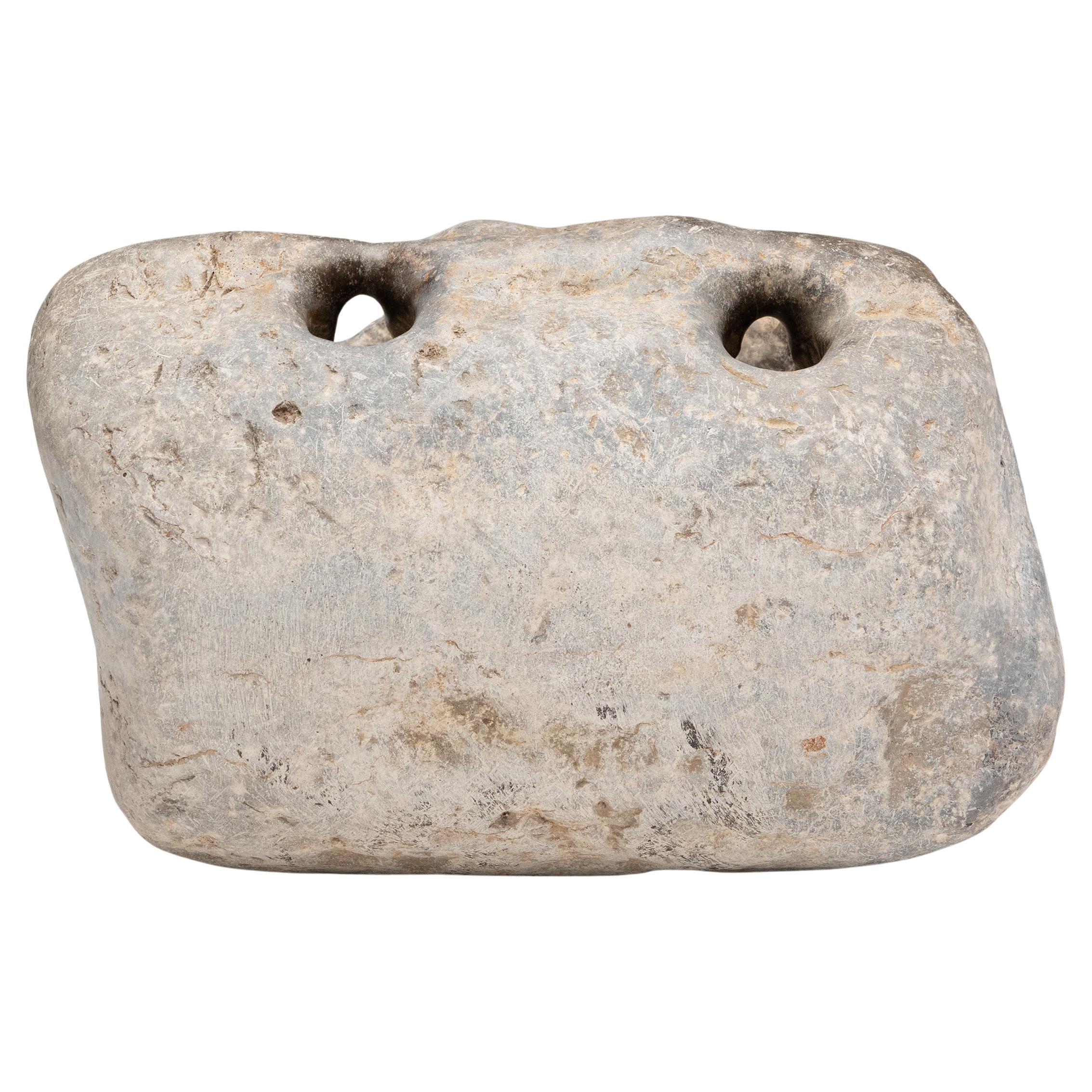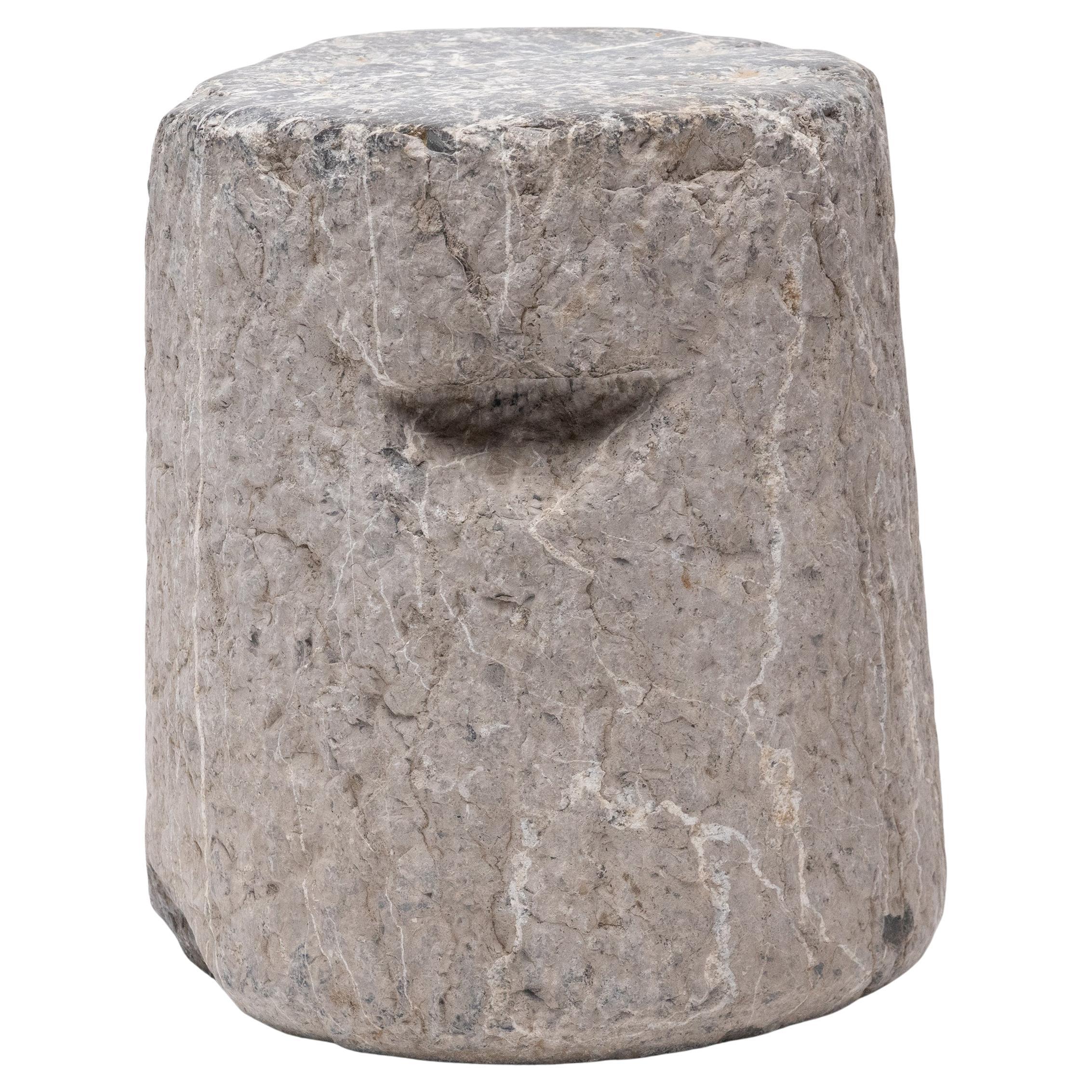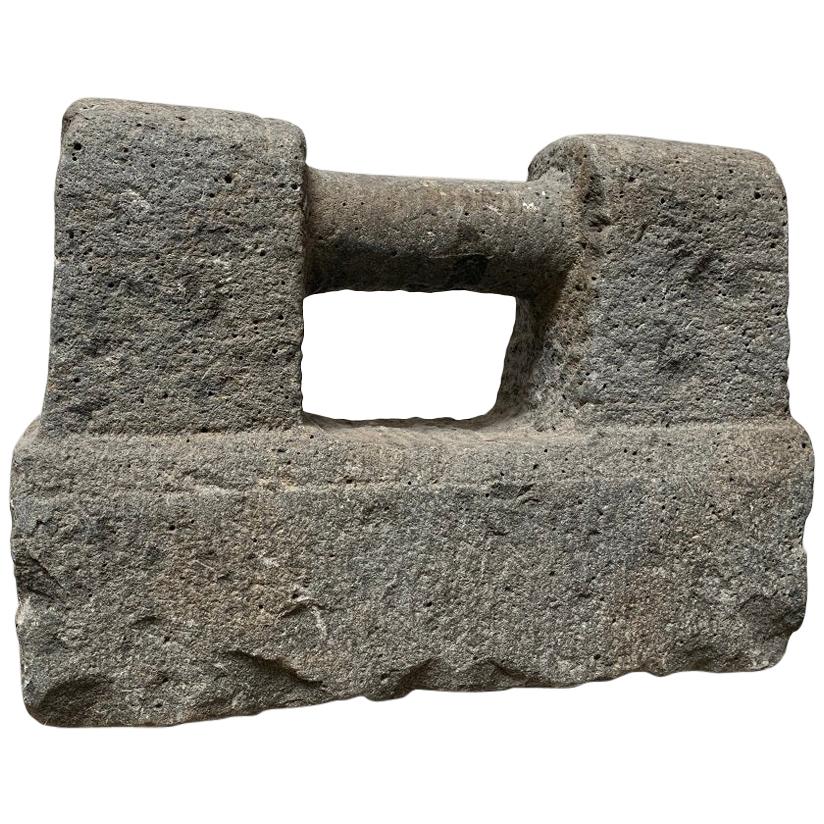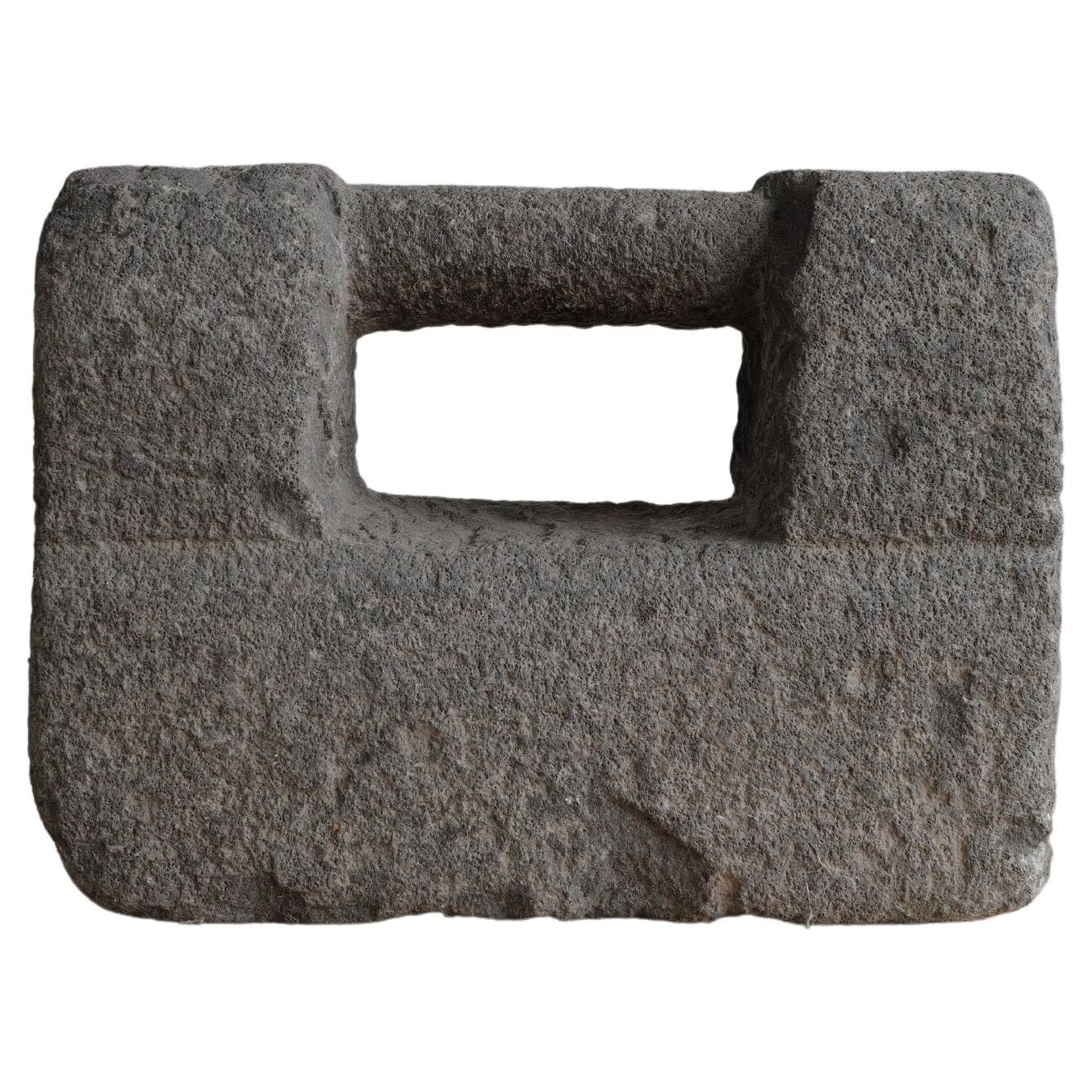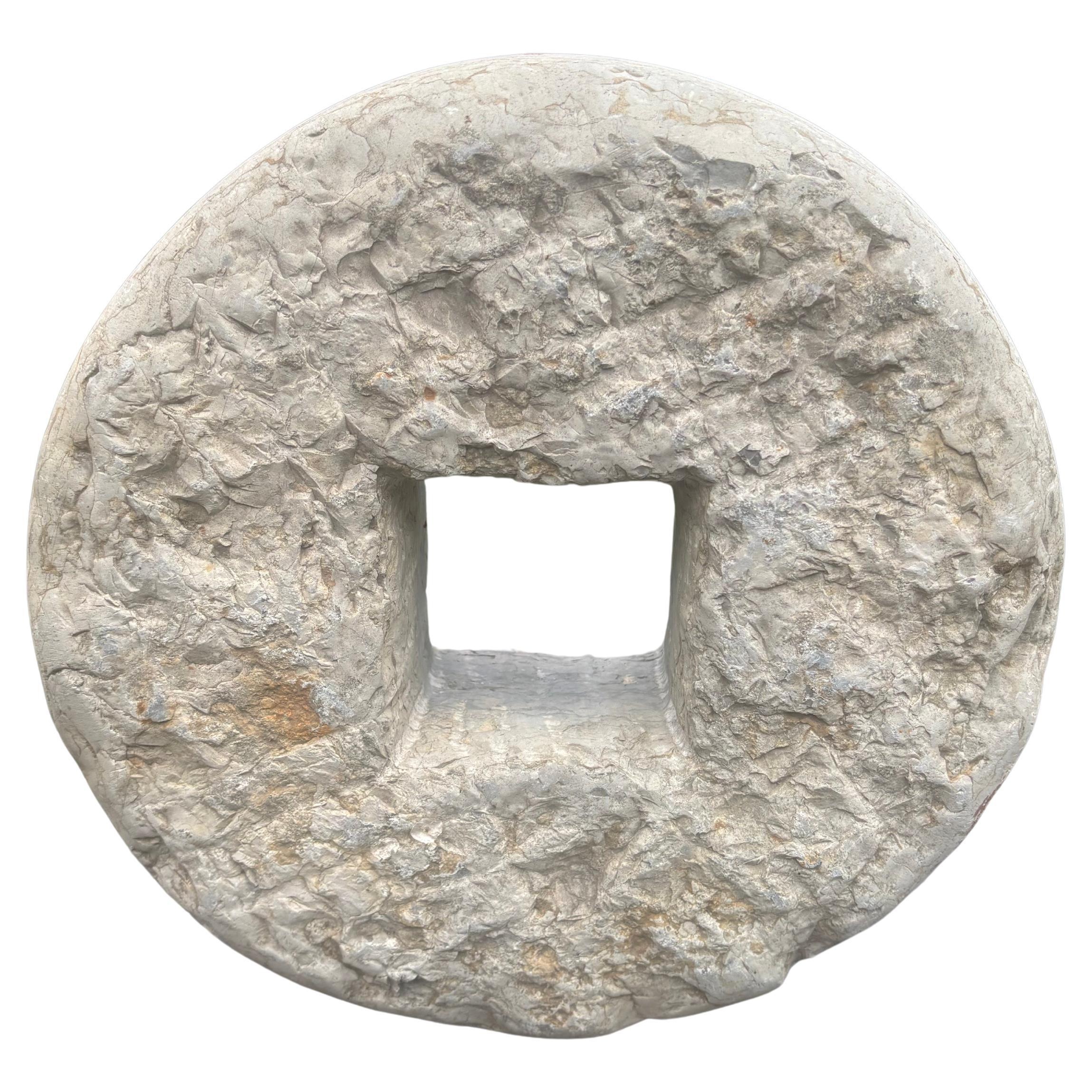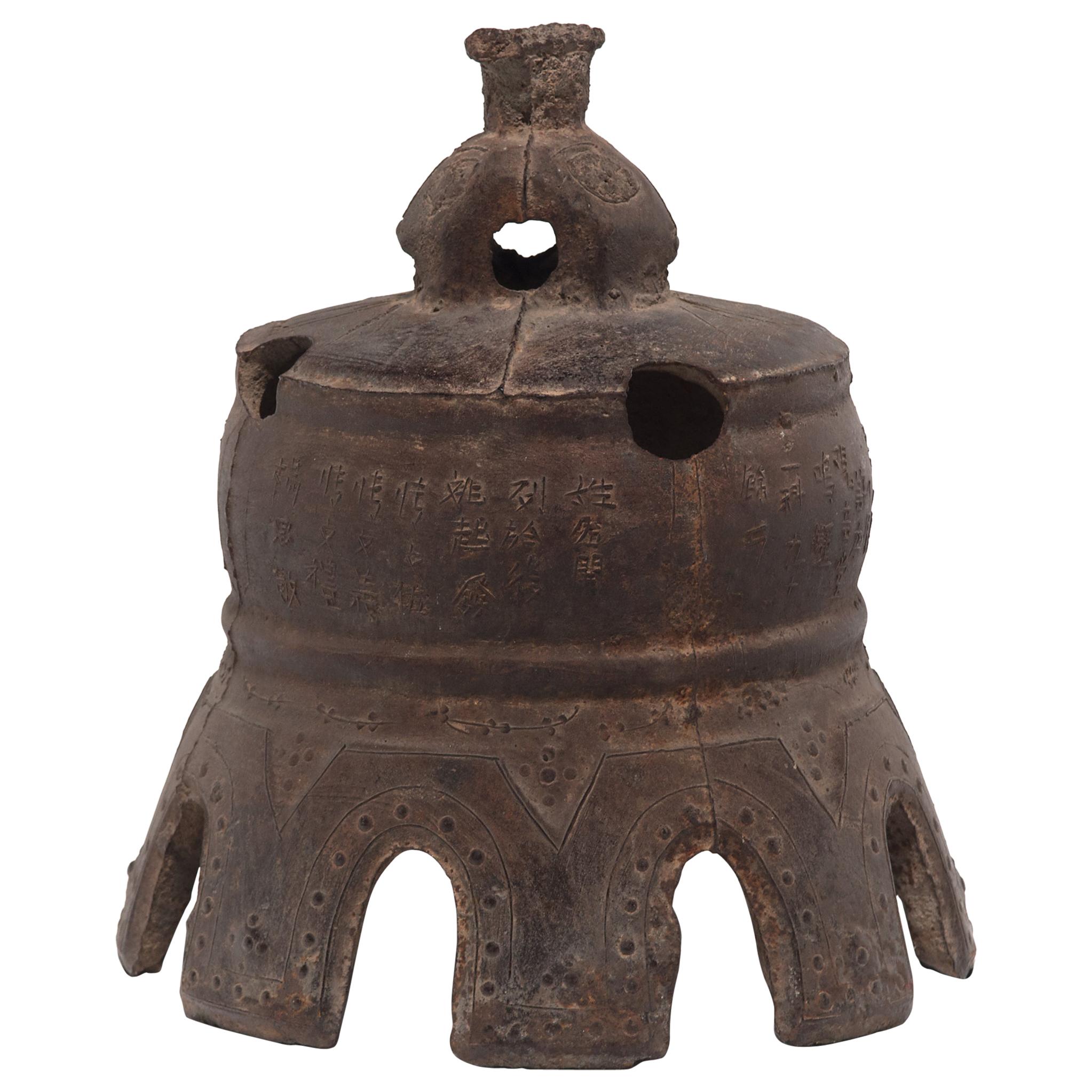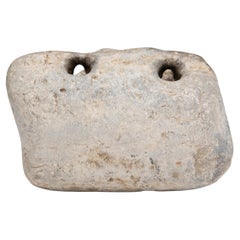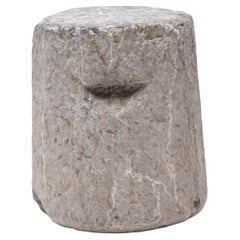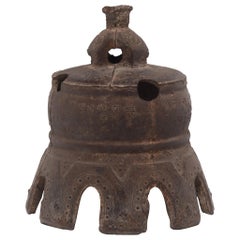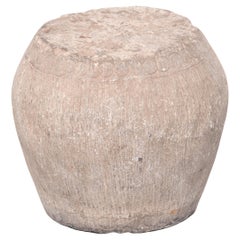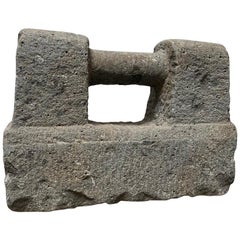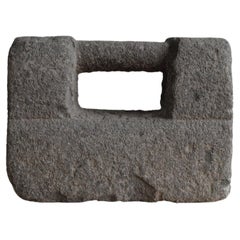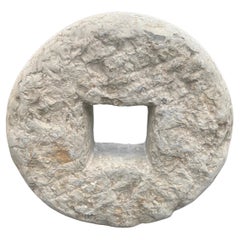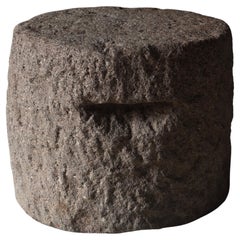Items Similar to Chinese Ishi Sashi Ingot Weight, c. 1900
Want more images or videos?
Request additional images or videos from the seller
1 of 5
Chinese Ishi Sashi Ingot Weight, c. 1900
$1,800
£1,359.55
€1,571.25
CA$2,524.78
A$2,808.20
CHF 1,469.75
MX$34,250.76
NOK 18,467.96
SEK 17,371.50
DKK 11,727.82
About the Item
Today known by the Japanese name “ishi-sashi,” meaning “awesome stone padlock,” this type of stone weight was used as part of intensive martial arts training. Hand-carved from solid limestone, the weight was used to strengthen one's arms and back, swung in the air much like a modern kettle bell. While most ishi sashi are carved in the shape of a padlock, this example has flared sides and sloping curves to resemble a large ingot, bestowing the user with blessings of wealth and prosperity in addition to strength.
- Dimensions:Height: 9 in (22.86 cm)Width: 16 in (40.64 cm)Depth: 7.75 in (19.69 cm)
- Style:Qing (Of the Period)
- Materials and Techniques:
- Place of Origin:
- Period:
- Date of Manufacture:c 1900
- Condition:Wear consistent with age and use. Minor losses.
- Seller Location:Chicago, IL
- Reference Number:Seller: ZHA0571stDibs: LU820044235232
About the Seller
5.0
Platinum Seller
Premium sellers with a 4.7+ rating and 24-hour response times
Established in 1997
1stDibs seller since 2006
1,706 sales on 1stDibs
Typical response time: 1 hour
- ShippingRetrieving quote...Shipping from: Chicago, IL
- Return Policy
Authenticity Guarantee
In the unlikely event there’s an issue with an item’s authenticity, contact us within 1 year for a full refund. DetailsMoney-Back Guarantee
If your item is not as described, is damaged in transit, or does not arrive, contact us within 7 days for a full refund. Details24-Hour Cancellation
You have a 24-hour grace period in which to reconsider your purchase, with no questions asked.Vetted Professional Sellers
Our world-class sellers must adhere to strict standards for service and quality, maintaining the integrity of our listings.Price-Match Guarantee
If you find that a seller listed the same item for a lower price elsewhere, we’ll match it.Trusted Global Delivery
Our best-in-class carrier network provides specialized shipping options worldwide, including custom delivery.More From This Seller
View AllChinese Stone Lock Counterweight, c. 1850
Located in Chicago, IL
Devoid of figurative carvings, this primitive stone weight from the mid-19th century has an organic, abstract beauty. The stone has an oblong, lock-form shape with natural asymmetry ...
Category
Antique Mid-19th Century Chinese Qing Sculptures and Carvings
Materials
Limestone
Chinese Stone Martial Arts Weight, c. 1900
Located in Chicago, IL
This curious stone object is a late 19th-century exercise weight, once used as part of the intensive training for martial arts and theater performers. Hand-carved from solid limeston...
Category
Early 20th Century Chinese Minimalist Garden Ornaments
Materials
Limestone
Grand Chinese Qing Dynasty Village Bell, circa 1800
Located in Chicago, IL
This lovely Qing-dynasty bell once pealed in a Chinese village, sounding out in celebration or giving notice of important events. Expertly forged, the cast-iron bell is detailed with characters in intricate relief, and its exaggerated scallop rim is traced with oversized rivets. Frosted with snow or lit from within by flickering candles, this sculptural bell takes on a magical presence in the winter...
Category
Antique Early 19th Century Chinese Qing Garden Ornaments
Materials
Iron
Petite Stone Drum Pedestal, c. 1850
Located in Chicago, IL
Look closely and you can just make out the hand-carved details that once made this small stone stool resemble a drum. A ring of circles along the top and bottom imitates bosshead nai...
Category
Antique Mid-19th Century Chinese Qing Garden Ornaments
Materials
Limestone
Chinese Round Hitching Stone, c. 1850
Located in Chicago, IL
Unlike many objects of its kind, this limestone hitching stone was carved into a simple rounded shape without any figural references. Used to secure a horse by rope or reins, the sto...
Category
Antique Mid-19th Century Chinese Qing Garden Ornaments
Materials
Limestone
18th Century Chinese Stone Guardian Sculpture
Located in Chicago, IL
This ancient stone guardian lion shizi was carved by hand out of a single block of limestone. The artisan beckoned the guardian out from the stone, manipulating the unyielding materi...
Category
Antique Early 18th Century Chinese Qing Sculptures and Carvings
Materials
Limestone
You May Also Like
18th Century Chinese Stone Artefact
Located in Vosselaar, BE
This double sided hitching post was used to stall horses for short period of times. They are found throughout China and made during centuries. This hardstone example dates from the 1...
Category
Antique Early 18th Century Chinese Sculptures and Carvings
Materials
Stone
Collector’s Martial Arts Stone Weight — 19th Century, China
Located in Antwerpen, BE
A sculptural artifact with commanding presence, this 19th-century Chinese martial arts stone weight embodies strength, discipline, and timeless craftsmanship. Originally used for phy...
Category
Antique Mid-19th Century Chinese Brutalist Abstract Sculptures
Materials
Stone
Antique Hand-Carved Cash Coin Garden Stone, 19th Century
Located in South Burlington, VT
Unique garden accent
This delightful round hand-carved stone in the form of an old "cash coin" with its square hole dates to the 19th century. This was likely originally a mill ston...
Category
Antique 19th Century Chinese Qing Sculptures and Carvings
Materials
Limestone
Japanese Antique Stone Display Stand / Objet / Before 1868s / Wabi-Sabi Mingei
Located in Iwate-gun Shizukuishi-cho, Iwate Prefecture
This is an old stone stand in Japan.
I don't know the details if it was used as a stand for beating straw, but it seems to be before the end of the Edo period.
The round silhouette...
Category
Antique Mid-19th Century Japanese Rustic Antiquities
Materials
Stone
Chinese Ceramic Headrest
Located in Vosselaar, BE
A Chinese unglazed ceramic headrest with lovely patina and naieve carvings on both sides. ONe geometrical and one of a fantasy beast (griffion?). These headrests are found in difform...
Category
Antique Early 19th Century Chinese Ceramics
Materials
Ceramic
Tripod in the shape of a bronze vessel li, Zhou or Shang dynasty
Located in seoul, KR
The tri-lobed shape and combed ridges of this cooking pot increased heating efficiency by maximizing the vessel’s surface area. The shape of a bronze vessel li, with the body rising out of three hollow pointed legs to a wide moiuth with splayed-out rim. The exterior is covered with cord impressed pattern. The surface shows signs of oxidation from being buried in the soil for a long time.
Period: Zhou or Shang dynasty circa 1000 B.C.E.
Medium : Grey earthenware with impressed decoration
Type : Tripod vessel
Size : 29cm (Height) x 35cm(Diameter)
Condition : Good
Provenance : Acquired in late 1990s from Hongkong
Reference :
1) V&A Museum - ACCESSION NUMBER C.87-1954
2) Smithsonian National Museum of Asian Art - ACCESSION NUMBER F1984.13
3) The University of Chicago - OBJECT NUMBER 1989.1
4) The MET - Accession Number: 1972.275.5
5) Kyoto National Museum - Three-footed Earthenware Vessel
* Shang Dynasty Pottery (1600-1046 BCE)
The Shang dynasty, known for its significant advancements in bronze casting, also produced notable pottery. Shang pottery is characterized by its practical use and simple designs, reflecting the utilitarian needs of the society. The pottery from this period includes both coarse wares used for everyday purposes and fine, high-quality ceramics used in ritualistic contexts. Common forms include jars, bowls, and cups, often with a dark, burnished surface. One distinctive feature of Shang pottery is the use of gray clay, and many pieces display clear signs of oxidation, giving them a unique, mottled appearance. The decorations were typically incised or stamped, featuring geometric patterns, zoomorphic designs, and motifs that are also seen in Shang bronze...
Category
Antique 15th Century and Earlier Hong Kong Antiquities
Materials
Pottery
More Ways To Browse
Antique Weights
Chinese Weights
Antique Bell Weights
Antique Padlocks
Antique Chinese Bells
Japan Bell
Japanese Kettle
Chinese Kettle
Stone Garden Obelisk
Wrought Iron Obelisk
Cast Iron Bath
French Concrete Mushrooms
Garden Artichoke
Pair Stone Eagles
Paolo Soleri Wind Chime
Soleri Wind Chimes
Stone Gate Pillars
Bronze Garden Frog
